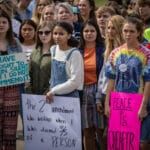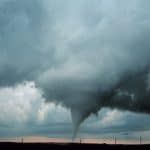Still surviving Hiroshima
By Hugh Gusterson | August 1, 2007
Even for those who lived through the first atomic bombings, it will always be August 1945.
“I’ve come to realize that the reason I’m alive is to tell people what happened, so they’ll
understand,” says Kiyoko Imori, the only one of 620 students in her school to survive the Hiroshima
bombing. Steven Okazaki interviewed more than 100 survivors of the bombing for his haunting film
White Light/Black Rain, which premieres Monday, August 6, on HBO. The film features clips
from interviews with thirteen of the survivors as well as four Americans on the planes that dropped
the bombs.
The two bombs dropped on Japan in August 1945 had a destructive force that stretches the limits
of human imagination. Creating temperatures of 9,000 degrees Fahrenheit and winds of 1,000 miles
per hour, they killed about 210,000 people immediately. Another 160,000 are estimated to have died
over the years from illnesses caused by the radioactive “black rain” that followed. That adds up to
about the population of Miami today. Gone.
After the war, the survivors, one of whom bitterly describes herself as a “guinea pig,” were
studied but denied treatment by U.S. doctors, though a handful were brought to the United States
for free plastic surgery. Many worry that they have passed on genetic mutations to subsequent
generations. Sumiteru Taniguchi, a teenage mail carrier on August 6, 1945, takes off his shirt and
matter-of-factly invites the viewer to look closely at the burns on his arm and back, the ribs
fused to skin, and bones so brittle they break if he coughs too hard. As a child being treated for
burns, the pain was so awful that he begged the doctors to kill him. “I’ve shown you my wounds
because I want you to know this can’t happen again,” he says.
Okazaki’s film, made with a Japanese-U.S. production team, evokes the atomic bombings and their
aftermath by interweaving such interview material with newsreel clips, survivors’ paintings of the
firestorm, and long-suppressed archival footage of the aftermath. There is no narrator, but there
is a moodily atmospheric soundtrack in the style of “This American Life.” Some of the images in the
middle of the film are very hard to look at, unless you’re a pathologist, but it’s important we not
look away from what was done in our name.
“I can’t describe what I witnessed. I don’t have the words. It’s like when you burn a fish on
the grill. That’s what they looked like,” a survivor recalls. One of the burned fish, a woman now
reconstructed by plastic surgery, describes her father peeling her charred face away from her head
with scissors. Another recalls looking at a woman whose body had been burned beyond recognition and
realizing from the gold tooth that it was her mother. As she and her sister reached out, their
mother crumbled to ashes before their eyes. “This happened 60 years ago, but I’ll never forget it,”
she says quietly.
Okazaki slips between such survivor accounts and the testimony of four Americans on the planes
that bombed Hiroshima and Nagasaki. The Japanese and Americans in the film–victims and
executioners–are irrevocably linked by the bombings, but their narratives of what connects them
are surreally divergent. The disconnection between their perspectives is as unsettling as the
images of dead and disfigured bodies. While the survivors tell deeply personal and cinematically
vivid stories of indescribable destruction on the ground with an arresting stillness, the Americans
seem never to have descended psychologically from the altitude at which they overflew the cities
they destroyed. (The one exception is the Enola Gay copilot who tears up when he meets a Hiroshima
survivor in a 1950s TV show clip.)
Harold Agnew, who went on to become director of the Los Alamos National Laboratory, where the
Bomb was developed, laughs slightly as he says, “I wrote in my notebook, ‘It went off. It really
did!'” Explaining that he simply wanted to win the war, he adds, “No sympathy, no regrets.”
Theodore Van Kirk, the navigator, saying he was proud “we dropped it on time, on target,” tells the
viewer he “never had a nightmare, never had a dream on this particular subject. Never had a
nightmare, period.” Such banal serenity is disturbing.
White Light/Black Rain comes at an opportune moment. Arms control experts are newly
concerned that, at a time when 400,000 Hiroshimas wait in storage in today’s nuclear stockpiles, a
U.S. city will go the way of Hiroshima and Nagasaki, destroyed by nuclear terrorists. Meanwhile the
last Hiroshima veterans–both those who dropped the Bomb and those who endured it–are passing from
this world, leaving behind only the archival shadow of their experience. All this at a time when
our ability to think about Hiroshima feels stuck: In 1995, the last time the United States tried to
think seriously about Hiroshima, outraged veterans, politicians, and pundits forced the
cancellation of a Smithsonian exhibit on the atomic bombings in Washington, D.C., rather than allow
the public to know what professional historians have to say on this matter; and only last month,
Japanese Defense Minister Fumio Kyuma was forced to resign for speaking the unspeakable in
Japan–that the bombing of Hiroshima might have been justified.
White Light/Black Rain dramatizes the feeling of being stuck through an inventive visual
device: Many of the survivors are shown standing immobile in a public place, clutching a photo of
themselves shortly before the Bomb split their life in two, and the camera slowly zooms in on the
juxtaposed images of the person that was, now miniaturized, and the person that is, while
pedestrians stream by all around. This posed immobility amidst the flow of life conveys as much as
any verbal testimony that, for the survivors, it is always August 1945.
In their own way, Americans are frozen in time with the survivors. If the survivors are
inexorably pulled back, as if by a force of historical gravity, to that moment when the splitting
of the atom split history, Americans seem to be frozen by a refusal to look afresh at what was done
in their name. The 1995 Smithsonian exhibit, timed for the fiftieth anniversary of the bombings,
was scrapped because it included a Japanese schoolgirl’s charred lunch box, photographs of cooked
and disfigured bodies, and a window into the discussions of professional historians. Some of these
historians argue that it is not true that a million U.S. soldiers would have died in a land
invasion of Japan, as Secretary of War Henry L. Stimson later claimed; that the Japanese would have
surrendered soon without either invasion or the Bomb; that the second bomb, dropped on Nagasaki,
was gratuitous and unnecessary; that the bombing was as much a message to the Soviets to behave
themselves as a way to end the war with Japan; or that the architects of the Bomb pushed for
careerist reasons to see their invention used.
Critics have accused these historians of “revisionism.” This is a curious accusation, since
revisionism is the job description of the historian. If revisionism were not allowed, what would
historians do? As new documents become available, and as the distance of time enables new
perspective, historians are supposed to enrich our national conversation by asking new questions
and revising the past. Otherwise our memory of the past, and thus our understanding of the present,
is cryogenically frozen and the heartbeat of national conversation falters.
Filmmakers, like historians, work to help us see anew.
White Light/Black Rain neither explains nor judges the bombing of Hiroshima and Nagasaki.
Okazaki, an American of Japanese descent, simply asks us to look closely, unflinchingly at what was
done, and to accept the witness of the survivors in the twilight of their lives. “All this pain we
carry in our hearts and in our bodies, it must end with us,” says Sakue Shimohira. Until we can
look at the schoolgirl’s charred lunch box, until we can take in the suffering of the survivors,
our defense of Hiroshima–if we still want to make one–will be dishonest. And until we look at
what these weapons do as unflinchingly as Okazaki’s survivors look into his camera, they will not
be able to die in peace, knowing that their message was heard.
White Light/Black Rain
airs August 6 at 7:30 p.m. on HBO. It will be repeated August 7 at noon and 10 p.m.; August 11
at noon; August 13 at 11:30 a.m. and 11 p.m.; August 19 at 3 p.m. and August 22 at 4 p.m.. It also
plays on HBO2 August 9 at 6 p.m.; August 16 at 12:30 a.m. and August 20 at 8 p.m. All times are
Eastern Standard Time.
Together, we make the world safer.
The Bulletin elevates expert voices above the noise. But as an independent nonprofit organization, our operations depend on the support of readers like you. Help us continue to deliver quality journalism that holds leaders accountable. Your support of our work at any level is important. In return, we promise our coverage will be understandable, influential, vigilant, solution-oriented, and fair-minded. Together we can make a difference.
Topics: Columnists














